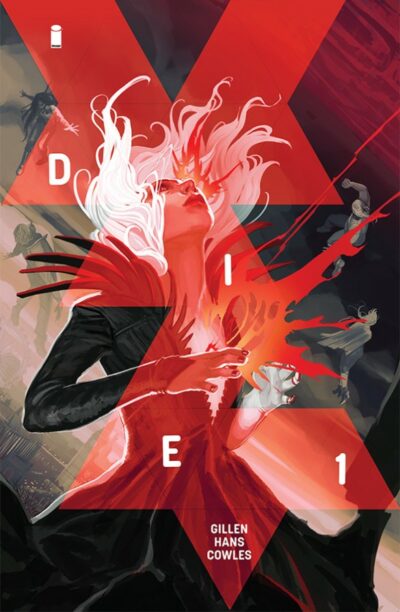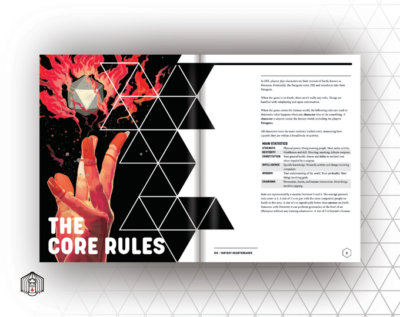
DIE is a brilliant comic book about role-playing from Kieron Gillen, Stephanie Hans, and Clayton Cowles.
DIE is also a brilliant storytelling role-playing game (RPG) from Kieron Gillen and Rowan, Rook and Decard.
This takes some explaining.
The thing you need to know right now is that if you want a deluxe physical copy of the RPG you have only three more days to Kickstart it, and if you want a deluxe physical copy of the entire comic run you can pre-order it right now (including pre-ordering from your local comic shop – yes, it’s already time to pre-order November hardcovers).
Okay, now on to the explaining!
DIE is one of the most-fascinating indie comic books of the past few years, both in concept and execution. The comic has already come and gone – it ran for 20 self-contained issues from December 2018 to September 2021 in four tight 5-issue arcs with no fluff.
(Mild first-issue spoilers lie ahead.)
The story started something like Stranger Things: 25th Anniversary Reunion.
A group of friends used to play role-playing games together in high school, but it ended with their sudden, inexplicable disappearance – and just-as-sudden reappearance years later, minus one member of their party and with a bevy of physical and psychological scars.
Where were they? They’ve never uttered a word about it to each other or anyone else and went on with their lives. Some of them were successful, some started families, while others could never shake their trauma and subsequent guilt.
On the anniversary of their disappearance they receive an unsettling reminder of their shared experience and they cannot help but be sucked back into something they know is much more serious and deadly than any game.
There are plenty of “real world people are transported into fantasy” stories out there, but DIE had a special, undeniable magic to it.
Central to that were the real world characters – five wounded adults, some of whom had spent their lives trying to be completely different than their game characters while others chased after becoming more like their fictional selves. They each had relatable stories about loss, addiction, identity, and disability, and those themes were amplified by the fantastical world around them.
As the story progressed, it became clear that this was a fantasy story with a very specific structure. In fact, the structure was so well-formed we could refer to it as a set of rules.
That’s because Kieron Gillen, in all of his wild genius, not only scripted a 20-issue comic story, but also the complete ruleset of the role-playing game the characters were playing in the story.
Gillen began to unfurl the rules in back-up essays in each issue, and eventually collected a Beta-test version for people to sample – along with videos of him running sessions at ComicCons and via video.
As an RPG system, DIE is both wildly inventive and brilliantly streamlined. Its world is endlessly modular. It’s not just dungeons or dragons. It fits with any kind of story you want to tell. Do you love westerns, but also can’t resist Chinese mythology? How about a dash of bodice-ripping romance? That’ll work just fine in DIE.
(In fact, the structure of both the comic and the RPG is such that any story you tell in your campaign is automatically part of the DIE canon. To say more would be a spoiler, but it’s one of the main points in the KS campaign’s marketing.)

While the world-building is unrestricted, the gameplay is slickly simplified. Each character plays an archetypal class, and none of them are obvious staples of the sword-and-sorcery genre. Each class primarily uses one specific die to drive their unique powers, which all have a “deal with the devil” quality to them.
“The Dictator” rolls a 4-sided die and can bend anyone to her whim up… until she releases them and they despise her for what she’s done. “The Godbinder” rolls a 12-sided die and makes a string of divine bargains, paying each last one off with the next… until her biggest debts are called in.
The final genius of the DIE system comes in the set-up of the game. You don’t simply gather five friends and assign them the five different-sided dice while reserving the D20 for yourself. No. Your friends make up fictionalized “real world” characters who are all tied together by a central conflict, and then those fictional characters get thrust into a fantasy world to work out their problems while fighting for their lives.
If that sounds both confusing and potentially risky, know that Gillen has put a lot of thought and research into how gaming can be a safe, protected space, working with experts in the field to codify that into the ruleset.
(That also means you can take a set of characters in an existing roleplaying game and thrust them into DIE as a sub-adventure. Not that I’m playing to do that in my D&D campaign…)
You have three more days to jump aboard the absurdly successful Kickstarter campaign to acquire a full rulebook – £20 for a PDF or £40 for a standard hardcover, which puts it at close to the same price point as a D&D book.
One of the most fascinating things about the campaign is that it shattered its initial fundraising goal in the opening hours, which allowed it to focus its Stretch Goals on content from a a dozen additional creators rather than bells and whistles to entice more pledges. In fact, the “reward” for one of the stretch goals (which was met) was to pay all of those supporting creators more!
Kieron Gillen, Stephanie Hans, & Clayton Cowles have created one of the most compelling new worlds of fiction I’ve read in comics in the past few years, and they’ve given you a way to enter it yourself. I can’t think of many things cooler than that!